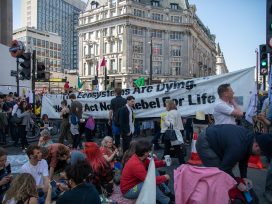“Cancer Alley”, stretching over 100 kilometres along the Mississippi River in Louisiana, produces about one-quarter of all US petrochemical products. There are over a hundred chemicals companies here, and the stretch is notorious for the adverse effects the emissions have on the health of the local population. “Cancer Alley” is just one of several high-profile cases in the United States that show how certain groups are disproportionately – unfairly – exposed to health risks and environmental degradation.
As usual, it is the economically and socially disadvantaged groups with no political influence – as in “Cancer Alley” – that suffer. Many would go so far as to say that there are clear elements of “environmental racism” at work in US environmental management. Since the 1970s and 1980s, this observation has fuelled a broad movement for environmental justice. Today, “environmental justice” holds a prominent place in the American environmental debate.
Moreover, it is not just in the US that environmental justice is being hotly debated. In South Africa, India and South America it has also emerged that some groups are more exposed than others to the health risks associated with industry, waste dumps and mining of natural resources. Now the justice factor has also begun to impact on the environmental debate in Europe, especially in the United Kingdom.
Yet this has barely happened in Sweden at all. Although the justice argument permeates the Swedish debate in almost all policy areas – employment, social security, taxes, immigration, education, infrastructure (including roads, broadband and digital TV) – environmental policy is an exception. A quick search for “environmental justice” on the websites of Swedish parliamentary parties, to see how they are framing their environmental policy, produces few hits. And a search on the websites of the major environmental organisations produces equally meagre results.
Whenever the solidarity argument has been invoked in Swedish environmental policy, it has been done so primarily in terms of international solidarity with the countries of the southern hemisphere. Domestic environmental disputes in Sweden, however, rarely address the distribution of environmental burdens, or the “environmental space”. Instead, they set exploitation against nature conservation, growth against sustainability and, to some extent, administrative policy instruments against economic ones. But perhaps now a change can be seen. A certain amount of research is currently being done on environmental justice; meetings and seminars on the “environmental space” and environmental justice are being arranged. In some cases, environmental justice is also being discussed in connection with planning and budget decisions at municipal level.
Environmental justice is not a clear-cut concept. As the US experience shows, it is about the distributional effects of the harm done to the environment and public health; about which groups and regions are exposed to the harm, the activities and facilities that cause it, and who benefits. In a more general sense, environmental justice is a question of how natural resources are consumed and how the “environmental space” should be distributed. In addition, environmental justice includes the option to obtain redress for the harm done to the environment and health.
It is obvious that environmental decisions have distributional effects. Industrial exploitation, mining extraction or the construction of a railway generally benefits some (access to raw materials, financial gain, better communications, jobs) and harms others (pollution, noise, health risks, destruction of nature).
However, in focusing solely on the distribution of the benefits and burdens, we lose sight of a key aspect of the whole justice debate: the fact that unbalanced distribution often occurs because certain groups, for various reasons, are unable to make their voice heard or influence either individual decisions or the underlying legislation. This marginalisation can be linked to class, social and economic status, ethnicity, skin colour and gender. It may arise because the law expressly distinguishes between different groups. But more usually, injustice arises even when legislation appears to be neutral: social norms, economic and other factors may still lead to some groups being shut out of the decision-making processes. This in turn impacts on decision-making and the distribution of the “environmental space”. Studies show how, for example, women in some parts of the world have less access to natural resources or are hit harder than men by environmentally damaging activities or scarcity of natural resources. Marginalisation may be a family affair as well as a local or national political issue. Environmental justice can thus be an argument for social change – for example, for strengthening the situation of women compared to men, or for the right of certain groups to a decent living environment.
The marginalisation of vulnerable groups is a recurring criticism in the US environmental justice debate. The American philosopher John Rawls, who had a greater influence on justice theory than anyone else during the 1900s, shows convincingly how distributive justice derives from a kind of participatory justice and equality of influence. He says that there can be no fixed distribution that is fair always and everywhere and that exactly equal distribution is not necessarily fair. Justice requires, rather, that every citizen – regardless of social class – should be guaranteed basic civil and social rights and given the same opportunity to take part in formulating equitable principles.
Using Rawls’s argument, we can say that environmental justice need not mean equal “environmental space” for everyone; distribution may vary from one situation to another. On the other hand all those concerned – including economically and socially disadvantaged groups – must have the same opportunity to make their voices heard and to take part in the social institutions and decision-making processes that determine what is to be understood by “equitable distribution”.
This is also an issue in Sweden, even though the rules are fairly flexible in terms of allowing people to be part of the decision-making process for the establishment of new plants and in municipal planning decisions. The problem here is not usually the right to take part in the decision-making process, but the ability to have any real influence on the outcome. It costs nothing to state one’s opinion or to appeal. On the other hand, it is expensive to obtain legal or other expert advice; in most cases, anyone wishing to go down this route will have to pay these costs out of their own pocket. At the same time it has become clear on several occasions how important it is, for example, to able to hire a lawyer to fight the case. Unsurprisingly, it will be easier for people from affluent Östermalm than from the more deprived Tensta – to use a Stockholm-based comparison – to get the help they need to fight the nuisance installations successfully. The differences in the ability of different groups and areas to make their voices heard can obviously have an impact on how and where roads, power lines or disruptive activities are sited.
Indeed, in the US one response to the criticism concerning the marginalisation of vulnerable groups in the environmental decision-making process has been to expand opportunities for public participation. However, one of the consequences has also been that it is primarily those groups that already tend to make themselves heard that are exploiting the improved opportunities to speak out.
The environmental justice debate has also expanded across state borders to include international contexts such as the global climate negotiations. There is a clear North-South dimension to these negotiations but they do not focus on individual situations but rather on those of different countries. The question is, which countries should “go first” and reduce their output of greenhouse gases. Given that industrialized countries, generally speaking, emit more greenhouse gases per capita than poorer countries, it would certainly seem reasonable to make greater demands on, for example, Sweden than India. This is the thinking behind the Kyoto Protocol and, roughly speaking, the division between rich and poor countries can also be applied when making a “justice” assessment.
At the same time, it would be problematic from a justice point of view if international discussions and negotiations were only to consider the situations of states. Take India, for example, where there is a middle class that enjoys the same living standards as in Europe and which equals the population of several European countries put together. If the climate negotiations focus solely on a country’s total greenhouse gas emissions in relation to population size, then India’s middle class will escape any international obligations without even having to make an effort to address uneven distribution at home. In other words, if the international environmental justice debate stops at national borders it will be blind to internal injustice.
In response to a state-centric concept of justice, in which the justice aspects of environmental protection are only addressed within each country, a more cosmopolitan alternative is gaining ground. Cosmopolitan justice means that the situation of individuals must also be considered in cross-border and international contexts. Here, too, certain fundamental civil and social rights must be guaranteed. Changes in this direction can, in fact, be seen in international law, even if they are far too fragmentary to constitute a paradigm shift. The most obvious example is an international framework for more than 40 countries in Europe and Western Asia (Aarhus Convention), which aims to make environmental decision-making processes fairer.
However, there has been no equivalent progress in terms of the environmental responsibility of transnational corporations. There are currently no corresponding international rules on business expansion across national borders that attempt to make companies liable for the damage they cause in countries where there is no functioning legal system or legislation. In some situations companies can still hide behind state sovereignty and various corporate structures to avoid liability for damage to the environment, human health and property. The people affected thus have no legal institutions and processes to fall back on. In international law there has long been an apposite expression for these situations: déni de justice.
State sovereignty is a solid concept in the international arena and it impacts on the way international rules are designed. At the same time, sovereignty – in the wake of globalization – has been watered down in various ways. It is not inconceivable that, going forward, the international framework for climate change may come to be characterised by a more cosmopolitan dimension of justice. If so, then international environmental policy and legislation would become a lever for environmental and social justice in poor countries.
Although Sweden is often the paragon of solidarity when it comes to developing countries in international contexts, the international environmental justice debate has gone almost unnoticed in domestic politics. It is perhaps not so surprising that the Green Party’s environmental policy has not been underpinned by the justice aspect. If anything, the party’s environmental ideology has emerged as a holistic concept, focusing on the social system and the biosphere in general. Sustainable development is the slogan and the justice aspect emerges mainly in the Swedish environmental movement’s discussions of the “environmental space” and the interests of future generations. On the other hand, some environmental groups have legitimately criticised the justice debate for being too anthropocentric, in other words for only looking at how benefits and burdens are distributed amongst people and ignoring the impact of distribution issues on non-human creatures.
What is more surprising is that neither the Social Democrats nor the Left Party have highlighted the distribution and justice dimensions of environmental policy. In a brief paper on the environment, welfare and democracy in the early 1970s, Tage Erlander said that, while some environmental problems affect everyone, there is clearly no reason to accept “social evils of the type that environmental degradation brings in the welfare state”. Today, however, the Left rarely talks about environmental protection and harmful environmental and health effects in relation to vulnerable groups or classes. When did we last hear anyone talking about solidarity with urban areas or groups that are exposed to environmental and health risks?
On the few occasions that the justice aspect of environmental policy is brought up, it tends to come from the conservatives; in that case it is in defence of landowners, especially farmers and foresters. The argument is that they have been hit too hard by environmental restrictions. They maintain that it is unfair that landowners are not adequately compensated when their right to use the land is restricted because of nature reserves or other forms of protection.
Crying out for justice could, of course, be a cheap rhetorical trick just to serve one¹s own purposes, but there could also be a rhetorical explanation for the lack of a justice dimension: to make a show of unity and to avoid any polarisation, in spite of the distributional effects and any underlying conflicts of interest.
I have no objection to environmental policy focusing on sustainable development and target efficiency when it comes to achieving environmental objectives on, for example, climate stability, protection of endangered species, clean air and clean water, as efficiently and economically as possible. But targeting must not be allowed to hide the distribution effects of environmental policy and environmental legislation. There is no “Cancer Alley” in Sweden, but environmental policies, legislation and individual environmental decisions determine who is affected by the harmful effects and how the “environmental space” is divided up.
Decisions on road corridors, industry permits, congestion charges, investment in public transport, residential environments, area protection, emissions trading, land decontamination, enforcement of existing regulations, all have distributional effects. Environmental justice and the “environmental space” are also affected by the decisions we make ourselves: how we get to work, how we travel, what we eat and consume and so on.
A serious environmental policy has nothing to gain from peddling rhetorical clichés on justice. In contrast, it should highlight specific injustices in the distribution of benefits and burdens, decision-making and the “environmental space”. This would strengthen the arguments for making those who play a greater part in environmental problems to be held more accountable, and for supporting those who tend to be hardest hit.






